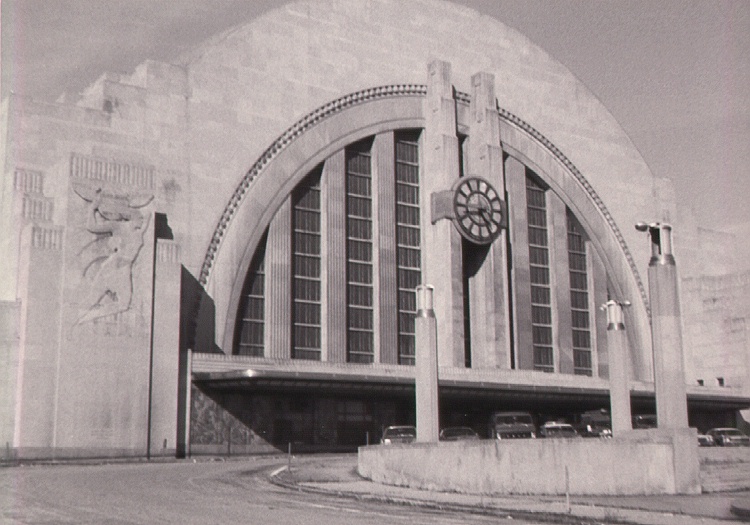Cincinnati Union Terminal
On March 31, 1933, a beacon of light shone in the darkness of the
Great Depression. Cincinnati Union Terminal was officially
dedicated. More than three and a half years effort had been
required to construct what is probably the greatest of the Art Deco
style railroad stations in the United States. Architects Alfred
Fellheimer and Stewart Wagner (who had earlier designed Buffalo Central
Terminal) teamed with design consultant Paul Cret, contractor A.M.
Stewart and artist Winold Reiss to create a masterpiece of Art Deco
form, function, and beauty. The station was a testament to the
courage and dedication of her builders during a time of deep national
crisis.
Cincinnati had long wanted to consolidate railroad services in a
union station. Seven railroads used five separate passenger
terminals. Finally, the man who would get the railroads and civic
government together, appeared in Cincinnati. He was George Dent
Crabbs, a well respected businessman and civic leader. A plan to
consolidate services and provide a magnificent gateway for the Queen
City of the Ohio was begun. The seven railroads in 1933 were:
Baltimore & Ohio, New York Central (Big Four), Pennsylvania,
Chesapeake & Ohio, Norfolk & Western, Southern, and Louisville
& Nashville.

Before her rescue & restoration,
Cincinnati Union Terminal, July 1977.
Photo by Jon Rothenmeyer.
Located somewhat remote from the business district, like Buffalo,
the station was conceived as a grand entrance way to the city. A
spacious public plaza and approach roadway sweeps down from the
symmetrically styled building to the city. The great rotunda rises
some 120 feet as a half dome, and encloses the main concourse
semicircular floor plan whose diameter is 178 feet. A 1933 account
described it: "The large free space under the dome is unusually
impressive, and creates in the observer a distinct sensation of
vastness." Tastefully selected materials of the Art Deco
movement, including stainless steel, aluminum, Verona marble, terrazzo,
and exotic South American woods such as zebrano and mahogany were
combined to "secure dignified, restful and pleasing
effects." Soft leather covered settees and chairs arranged in
informal groups in the concourse waiting room replaced the traditional
long wooden bench. Cincinnati Union Terminal included not only
specialty shops, newsstands, barber shop, and restaurants, but also a
small 100 seat theater for the showing of newsreels. Stairways and
ramps to the train platforms were modeled after the ones very
successfully employed in Buffalo's Central Terminal.
By far however, the richest feature of the station were its huge
mosaics depicting the history of Cincinnati, her industry, and the
importance of railroads to her prosperity. The great mosaics in
the rotunda survive today in all their colorful splendor. Those
located in the passenger concourse over the tracks were removed when it
was demolished and placed in the Cincinnati airport terminal
building. Eight track platforms could accommodate 17,000 people a
day. Train capacity was planned at 216 daily arrivals and
departures. New locomotive servicing facilities, including an Art
Deco style roundhouse were constructed north of the station. REA
express and mail facilities were located also to the north of the
building. A power plant located over a mile away from the station
provided steam for heating and auxiliary purposes. Passengers
arriving on the approach boulevard instantly knew the correct time from
a 20 foot diameter clock with red neon hands that was incorporated into
the great front arched window. Brilliant color flood lamps
illuminated the plaza fountain at night.
In the summer of 1977, Jon Rothenmeyer and I visited Cincinnati to
ride the Chessie Steam Special. We departed CUT from the only
remaining track platform. The main rotunda was occupied by some
seedy businesses. Regular rail passenger service was long removed,
but the essential quality and timeless beauty of the building remained.